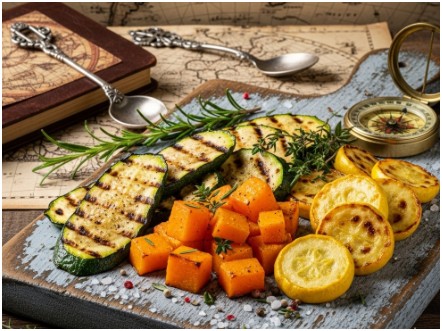I’ll be honest, when I first started making zucchini and squash, I completely screwed them up. I put them in a pan and ignored them. They became a tasteless and soggy blob.
After wandering through kitchens from Thailand to Tuscany, it dawned on me that these two innocent vegetables deserve attention. Equal attention as to a beautiful fillet of fish or piece of steak.
If you know how to cook zucchini and squash, they can produce flavors that are elegant yet rustic.
Basically, the flavor of every meal can be described by these two simple yet complex vegetables. All that’s needed is timing, heat, and deciding which cooking method feels right in the moment.
Why Do People Love Squash and Zucchini?
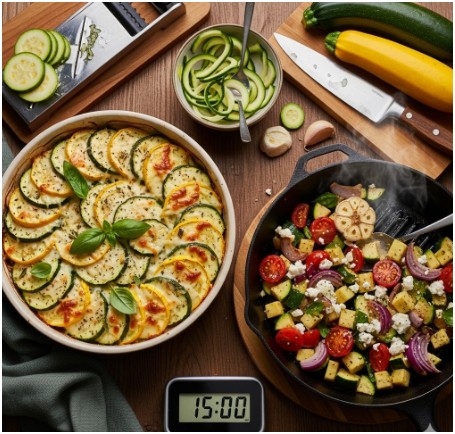
It’s easy to incorporate vegetables like zucchini and squash into your regular meals. They don’t require peeling because of their thin skins, and their mild flavor complements seasoning well.
While cooking in Italy, I observed how the natives painted zucchini with cheese, herbs, and olive oil, treating it like a blank canvas.
In Greece, the same vegetables were mixed with onion and garlic in sizzling pots, creating scents that may entice neighbors to the meal.
They’re also really quick. These beauties cook in less than 20 minutes, unlike root veggies that require a lengthy roasting time. They are therefore ideal for weeknight meals or unexpected visitors.
What is the Best Way to Cook Squash and Zucchini?
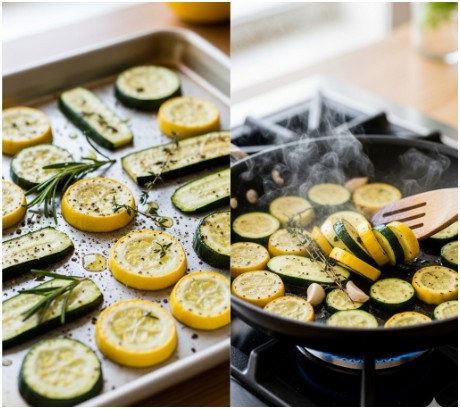
The most important lesson I’ve learned over the years is that there isn’t a single optimal approach. This depends on what you want.
If you like sweetness with a touch of caramel, roasting is your best bet. If you want buttery smoothness in a few minutes, sautéing is a must.
Both methods respect the natural properties of the plants, albeit in slightly different ways.
In both cases, avoiding crowding is essential. It is impossible to overstate this.
If you pack a pan or baking sheet too full, it will steam instead of scorch. If you give them space, you’ll get flavor.
How to Roast Squash and Zucchini Without Soggy Results
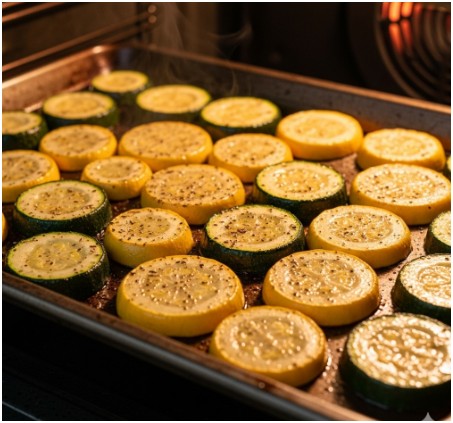
Roasting is a magical process. Natural sugars are caramelized by the high oven heat. This process adds a rich, sweet taste to every bite.
I first developed this method when a cook in a country kitchen in Provence requested that I not use parchment paper.
He said, You’ll taste the difference if you let the metal touch the vegetables. He was right.
- Slice the zucchini and squash into half-inch pieces first.
- Toss in the olive oil, garlic powder, and Italian herbs.
- Place them on a baking sheet in a single layer.
- The oven should already be at 425°F to get that golden edge.
- Roast for 20 to 25 minutes, turning once.
- For a final touch, sprinkle with Parmesan or fresh parsley as they come out.
The outcome? Summertime sensations captured on a plate, with soft centers and crisp edges.
How to Sauté Squash and Zucchini Like a Pro
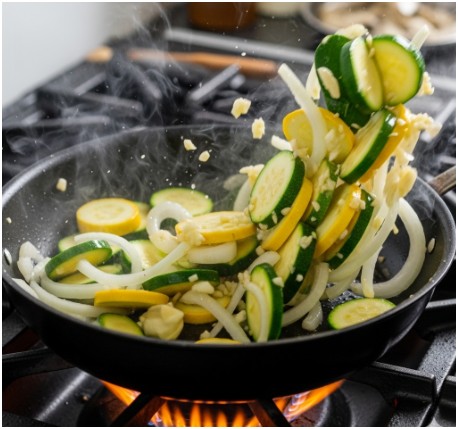
Sautéing is quick and satisfying.
We had seconds, not minutes, to get the vegetables from the skillet to the dish when I was cooking in a busy Thai restaurant. I learned the power of high heat and persistent movement from that urgency.
- Cut your squash and zucchini into rounds or half moons.
- In a large skillet, heat the butter and olive oil.
- Slices of onion should be added, let to soften, and then garlic should be stirred in until the room is fragrant.
- Add the vegetables now.
- Before flipping, give them a chance to caramelize by stirring them every few minutes. They will be soft but still lively after 8 to 10 minutes.
- Add salt, pepper, and possibly a dash of red pepper flakes toward the end.
If you want it rich and decadent, sprinkle Parmesan on top. These veggies taste great, so serve them right away.
How to Cook Squash and Zucchini: Step-by-Step
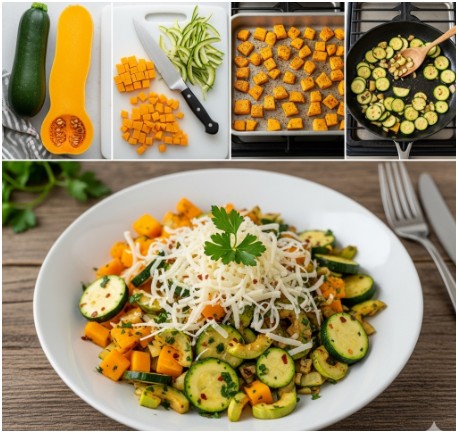
Trim and clean the vegetables. Don’t peel them because the skin gives them texture.
Make sure to cut them evenly so they cook at the same pace. You can sauté with garlic and onion in a skillet or roast with oil and herbs at 425°F.
Keep the heat on high and the pan empty. This helps to prevent sogginess. Serve hot, garnished with cheese, parsley, or chili flakes.
Both methods take less than 25 minutes from start to finish. Your choice will depend on whether you prefer a quick stovetop flavor or a deep oven roast.
Can You Add Extra Flavors?
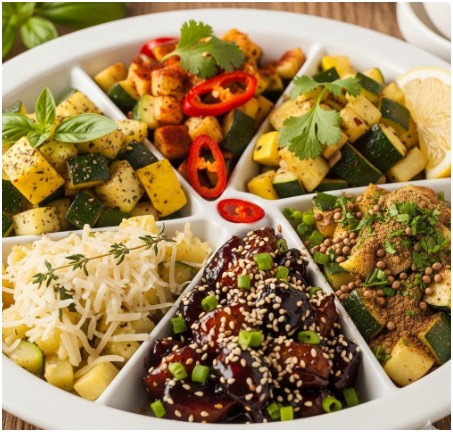
Absolutely. Creativity is at its best there. I often mix Mediterranean herbs like oregano and basil for roasting.
Mexican cooks prefer to add chili flakes for a spicy edge. In France, a little Parmesan cheese is practically a necessity. These vegetables are sponges for flavor, so don’t hold back.
Try experimenting with Asian soy-ginger glazes, Middle Eastern cumin and coriander, or even smoky paprika for a Spanish flair. Each country I’ve visited has its own distinct method, and they were all quite successful.
FAQs About How to Cook Squash and Zucchini
Do you need to peel squash and zucchini before cooking?
Not at all.
Their skin is thin, delicious, and nutrient-rich. I suggest leaving the skin in situ for texture and color, but peeling is completely up to the individual. It also aids in the vegetables’ ability to hold their shape when cooking.
How do you keep squash and zucchini from getting mushy?
Extreme heat and space are your best friends. Congestion causes steaming. Always cut evenly, cook quickly, and salt beforehand to remove any excess water. Serve right away for the freshest texture.
Can you cook squash and zucchini together?
Yes, they are the perfect match. The plate’s color contrast is stunning, and their cooking times coincide. Just cut them equally and season them accordingly for balance.
What seasonings work best?
They are enhanced by the addition of garlic, onion, and herbs, but simple salt and pepper also work nicely.
Parmesan provides richness, while red pepper flakes or chilli powder bring fire. Try a variety of items to suit your meal.
A Delicious Ending Worth Remembering
That concludes my adventure with these two unassuming vegetables. Cooking zucchini and squash taught me technique, patience, and a healthy respect for heat.
Now, what started off as a sloppy kitchen catastrophe feels natural. I can now sauté them for a late-night snack or roast them for a Sunday dinner.
Finally, don’t treat them like sidekicks; instead, treat them like the stars of the plate.
You’ll notice how much character they add when you add a squeeze of lemon, a sprinkling of herbs, or a coating of Parmesan.
It takes more than just feeding yourself to cook them effectively. It’s about appreciating the craft of turning the most basic elements into something truly remarkable.

